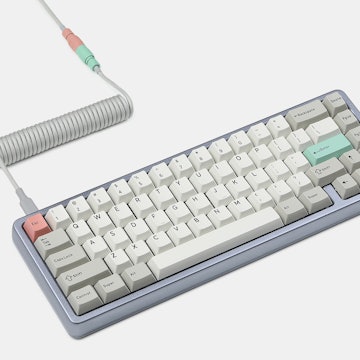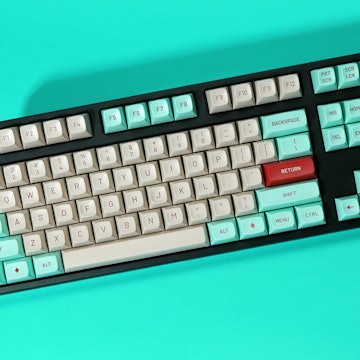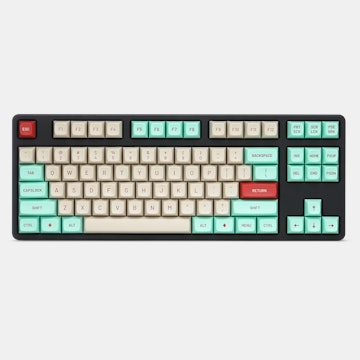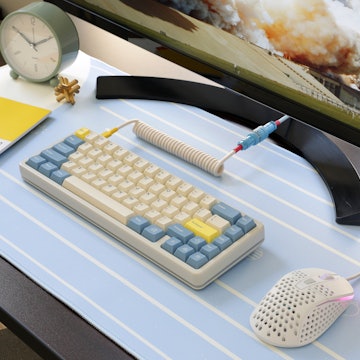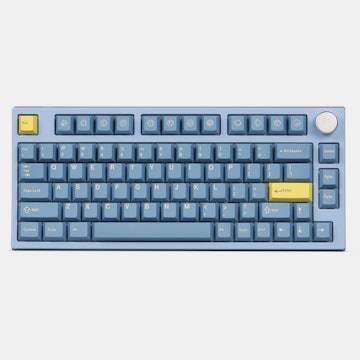Click to view our Accessibility Statement or contact us with accessibility-related questions







Showing 1 of 203 conversations about:

g0nz3r
10
Feb 4, 2017
bookmark_border
I wouldn't call electro-capacitive switches "linear", by any means.
bykacliat
4
Oct 30, 2017
bookmark_border
g0nz3rim kinda confused by all this "switch talk"..
dont they go linearly downwards like any other other keyswitch?
also is electro capacitive fancy for rubberdome?

g0nz3r
10
Oct 30, 2017
bookmark_border
bykacliatThen I will unconfuse you. Go get your favorite drink and strap in.
They go up and down, of course, but the key press is not linear. Switches like this one have a tactile bump corresponding to the actuation of a key press. Linear would be- No forceful acknowledgement of a key press, meaning no tactile bump indicating that you have successfully hit the switch. In theory, not having something to tell you that you've actuated a switch will make you have to push it all the way in, slowing down your typing speed.
Here are the 3 types of switches you will see people talking about
1. Linear Switches: No tactile or audible feedback to aver actuation. It feels like you're pushing down a spring under a key, because you are. Furthermore, throughout the key press there isn't very much added resistance as you get further toward bottoming out on these switches, at least in the vast vast majority of cases. A case where you would feel added resistance- Cherry MX Linear Grey, because they are heavy switches.
2. Tactile Switches: Tactile feedback to aver actuation. Sometime during the key press, there will be a "bump" in resistance that you must push through to in order to actuate your key press. In some cases, the bump can barely be felt, such as Cherry MX Brown, and in others, such as Cherry MX Clear or Electro-Capacitive switches, it can be clearly felt. The force curve of the force needed to push a tactile switch down is far from linear. You can find graphs of force needed over a press by looking at a given switch on Input Club's Comparative Guide. (I don't know if they allow URL's, so just Google it if you care to see it)
3. Clicky Switches: Tactile and audible feedback to aver actuation. Sometime during the key press, there will be the bump in resistance that tactile switches have, but it will also be accompanied by an audible clicking sound when you've pressed through it, letting you know that you've actuated the key. So, these essentially feel like tactile switches, but my experience is that their tactile bumps tend to be more pronounced at a given resistance level, possibly due to the mechanism producing the click being added. I suppose that clicky switches could forego the tactile bump and still be called clicky (or force us to add a new category), but I have yet to see it.
As alluded to above- Another thing to keep in mind is how heavy a given switch is. Most people like "light" switches, such as Cherry MX Red (Linear), Cherry MX Brown (Tactile), or Cherry MX Blue (Clicky). So, actuation force of around 35g to 60g. It's just something to keep in mind if you buy, because although lighter switches are more common, they do sell heavier ones and some people find them tiring. (You can find actuation force of a given switch online pretty easily, but Input Club's Comparative Guide is a very good "all-in-one-place" source.) ___________________________________
Finally- Electro-capacitive is not fancy for rubber dome, but it uses one. It is a hybrid tactile switch. It's just a Topre switch, but made by another company. "The switch consists of a slider in a housing over a rubber dome over a conical coiled spring over a printed circuit board." A capacitive sensing mechanism on the PCB itself avers the a key press right in the middle of the stroke, so the tactile bump doesn't correspond to actuation, as per usual with mechanical switches. It feels very unique, compared to other mechanical switches, and has become my favorite tactile switch. In fact, I am typing this on a Topre keyboard right now.
Despite not meaning "fancy for rubber dome", Electro-Capacitive switches feel like fancy rubber domes. The tactile bump takes up essentially the entire key press, which is very different from other mechanical switches where it just happens mid stroke and otherwise feels like you're pushing down a spring, because you are. With Electro-Capacitive switches, you're bottoming out, period. The bottom out is very different from other mechanical switches, because the dome softens it, while other switches have hard plastic just colliding as hard as you press the key. The press itself is very satisfying, in my opinion, although it varies by actuation force, as these switches come in different weights. It's hard to explain, but I think the best way to explain it is- Rubber domes with a nice "pop" and texture to them.
Sorry for being long winded- There was a lot to explain.
They go up and down, of course, but the key press is not linear. Switches like this one have a tactile bump corresponding to the actuation of a key press. Linear would be- No forceful acknowledgement of a key press, meaning no tactile bump indicating that you have successfully hit the switch. In theory, not having something to tell you that you've actuated a switch will make you have to push it all the way in, slowing down your typing speed.
Here are the 3 types of switches you will see people talking about
1. Linear Switches: No tactile or audible feedback to aver actuation. It feels like you're pushing down a spring under a key, because you are. Furthermore, throughout the key press there isn't very much added resistance as you get further toward bottoming out on these switches, at least in the vast vast majority of cases. A case where you would feel added resistance- Cherry MX Linear Grey, because they are heavy switches.
2. Tactile Switches: Tactile feedback to aver actuation. Sometime during the key press, there will be a "bump" in resistance that you must push through to in order to actuate your key press. In some cases, the bump can barely be felt, such as Cherry MX Brown, and in others, such as Cherry MX Clear or Electro-Capacitive switches, it can be clearly felt. The force curve of the force needed to push a tactile switch down is far from linear. You can find graphs of force needed over a press by looking at a given switch on Input Club's Comparative Guide. (I don't know if they allow URL's, so just Google it if you care to see it)
3. Clicky Switches: Tactile and audible feedback to aver actuation. Sometime during the key press, there will be the bump in resistance that tactile switches have, but it will also be accompanied by an audible clicking sound when you've pressed through it, letting you know that you've actuated the key. So, these essentially feel like tactile switches, but my experience is that their tactile bumps tend to be more pronounced at a given resistance level, possibly due to the mechanism producing the click being added. I suppose that clicky switches could forego the tactile bump and still be called clicky (or force us to add a new category), but I have yet to see it.
As alluded to above- Another thing to keep in mind is how heavy a given switch is. Most people like "light" switches, such as Cherry MX Red (Linear), Cherry MX Brown (Tactile), or Cherry MX Blue (Clicky). So, actuation force of around 35g to 60g. It's just something to keep in mind if you buy, because although lighter switches are more common, they do sell heavier ones and some people find them tiring. (You can find actuation force of a given switch online pretty easily, but Input Club's Comparative Guide is a very good "all-in-one-place" source.) ___________________________________
Finally- Electro-capacitive is not fancy for rubber dome, but it uses one. It is a hybrid tactile switch. It's just a Topre switch, but made by another company. "The switch consists of a slider in a housing over a rubber dome over a conical coiled spring over a printed circuit board." A capacitive sensing mechanism on the PCB itself avers the a key press right in the middle of the stroke, so the tactile bump doesn't correspond to actuation, as per usual with mechanical switches. It feels very unique, compared to other mechanical switches, and has become my favorite tactile switch. In fact, I am typing this on a Topre keyboard right now.
Despite not meaning "fancy for rubber dome", Electro-Capacitive switches feel like fancy rubber domes. The tactile bump takes up essentially the entire key press, which is very different from other mechanical switches where it just happens mid stroke and otherwise feels like you're pushing down a spring, because you are. With Electro-Capacitive switches, you're bottoming out, period. The bottom out is very different from other mechanical switches, because the dome softens it, while other switches have hard plastic just colliding as hard as you press the key. The press itself is very satisfying, in my opinion, although it varies by actuation force, as these switches come in different weights. It's hard to explain, but I think the best way to explain it is- Rubber domes with a nice "pop" and texture to them.
Sorry for being long winded- There was a lot to explain.
bykacliat
4
Oct 30, 2017
bookmark_border
g0nz3rAlright.. thank for the expaination^^ now im feeling bad for making you write so much lol
My keyboard has cherry mx reds and it always annoyed me that there is still so much keytravel after the actuation, so i bought fat transparent 2mm thick O-rings and now there is barely any travel after my keys actuate, which i like a lot more.
But now i really want to try out Topre switches and see if i like them more haha.

g0nz3r
10
Oct 30, 2017
bookmark_border
bykacliatDon't worry about the length. I write A LOT.
My first keyboard was a Cherry MX Red keyboard, and I haven't had linears ever since. I don't have a huge collection of mechanical keyboards, but I was buying a new one probably at an average of every 6 months before I got my Topre keyboard, which I have been using for nearly 2 years. So, I have quite a few mechanical keyboards, and the only linear one was my first one. It's kind of odd that Topre killed my collecting, but I really like it and I bet you would as well. Most people who try Topre like the switches. Despite having been thinking about picking up a new keyboard, a new switch hasn't interested me enough. I have been thinking about either building a Cherry MX Black keyboard (so I can lubricate the springs and maybe perform some mods) or obtaining a Vintage Cherry MX Black keyboard. Vintage MX Blacks are supposed to be better, but there are so many new switches around nowadays that maybe another company makes a better medium-stiff linear.
My first keyboard was a Cherry MX Red keyboard, and I haven't had linears ever since. I don't have a huge collection of mechanical keyboards, but I was buying a new one probably at an average of every 6 months before I got my Topre keyboard, which I have been using for nearly 2 years. So, I have quite a few mechanical keyboards, and the only linear one was my first one. It's kind of odd that Topre killed my collecting, but I really like it and I bet you would as well. Most people who try Topre like the switches. Despite having been thinking about picking up a new keyboard, a new switch hasn't interested me enough. I have been thinking about either building a Cherry MX Black keyboard (so I can lubricate the springs and maybe perform some mods) or obtaining a Vintage Cherry MX Black keyboard. Vintage MX Blacks are supposed to be better, but there are so many new switches around nowadays that maybe another company makes a better medium-stiff linear.
slumped1k
1
Sep 27, 2021
bookmark_border
g0nz3rare electro capacitive switches faster then apex pro tkls switches

g0nz3r
10
Sep 27, 2021
bookmark_border
slumped1kElectrostatic capacitive switches are a little faster than basic bitch Cherry and Cherry-esque switches, but it is a relatively close race. The OmniPoint switch in the Apex Pro TKL's are multiple times faster. That's the switch itself. All the other variables can easily make that not matter at all. For example- How your fingers rest above the key, how quickly you push the key, how much weight there is in the key press, how close the actuation point is, how fast the controller accepts and sends out the signal, how you are plugged into the computer.
If I were after speed for gaming, the first component I would optimize, after the GPU (for the specific game) of course, would be the monitor. As LinusTechTips demonstrated a few years ago or so, the speed of your display matters a lot. We are talking up to several kills per game in your favor when playing an FPS game against someone of equal skill, if they are only gaming at 60hz and you're on the bleeding edge. So, there is a good excuse to use a high refresh rate display.
If I had to put together a fast keyboard setup, though- I would probably just find the fastest gaming keyboard I could that supports plugging into a PS/2 port. PS/2 ports send a direct hardware interrupt to the CPU, so it is going to outdraw USB no matter what. The problem is that less motherboards support PS/2 these days, and companies selling keyboards have little to no incentive to mention support for it, given that keyboards have been using USB en masse since 1998. If the Apex Pro TKL supported PS/2, it would be a solid candidate. Me, myself, though? Right now? I wouldn't worry too much about the speed of the keyboard. I also wouldn't piss on Steelseries if they were on fire, though that is a discussion for another day.
slumped1k
1
Sep 28, 2021
bookmark_border
g0nz3rwell do u know what the fastest switch that is close to the omnipoints is







